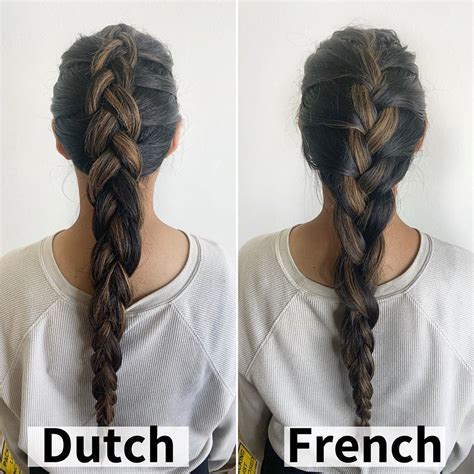Understanding French and Dutch Braids
Braiding is an ancient hair styling technique that has been passed down through generations. While there are numerous variations of braids, French and Dutch braids stand out as two of the most popular and versatile styles. Both braids create a sophisticated and elegant look, but they have unique characteristics that set them apart.

French Braid (Inside-Out Braid)
- Originates from France in the 16th century
- Involves three strands of hair, with new hair added from the sides as you braid downwards
- Creates a tight, intricate pattern with a raised effect
- Popular for its versatility, from everyday wear to formal occasions
Dutch Braid (Outside-In Braid)
- Originates from the Netherlands (hence the name)
- Similar to a French braid, but the strands are crossed over the top instead of underneath
- Produces a fuller, more voluminous braid with a slightly messier appearance
- Ideal for thick or curly hair and can create a more casual or bohemian vibe
Comprehensive Comparison Table
| Feature | French Braid | Dutch Braid |
|---|---|---|
| Origin | France | Netherlands |
| Direction | Inside-out | Outside-in |
| Appearance | Tight, intricate | Full, voluminous |
| Effect | Raised | Flat |
| Versatility | Formal and casual | Casual and bohemian |
Common Mistakes to Avoid
French Braid
- Pulling hair too tightly, which can damage hair follicles
- Not adding hair from the sides consistently, leading to an uneven braid
- Braiding too loosely, resulting in a floppy braid
Dutch Braid
- Crossing strands incorrectly, which can create a tangled mess
- Not holding the base of the braid securely, causing the braid to loosen
- Braiding too far apart, creating gaps in the braid
Step-by-Step Approach
French Braid:
- Section off a small portion of hair at the crown of your head.
- Divide it into three equal strands.
- Cross the right strand over the middle strand.
- Take a small section of hair from the right side and add it to the right strand.
- Cross the new right strand over the middle strand.
- Repeat steps 4 and 5 on the left side.
- Continue braiding down the length of your hair, adding hair from both sides as you go.
- Secure the end of the braid with a hair tie.
Dutch Braid:
- Follow steps 1 and 2 for the French braid.
- Instead of crossing the right strand over the middle strand, cross it under the middle strand.
- Take a small section of hair from the right side and add it to the right strand.
- Cross the new right strand over the middle strand (instead of under).
- Repeat steps 3 and 4 on the left side.
- Continue braiding down the length of your hair, crossing the strands over instead of under.
- Secure the end of the braid with a hair tie.
Pros and Cons Table
| Feature | French Braid | Dutch Braid |
|---|---|---|
| Versatility | High | Medium |
| Appearance | Elegant, sophisticated | Casual, bohemian |
| Ease of creation | Moderate | Moderate |
| Time required | Varies | Varies |
| Hair type | Most hair types | Thick, curly hair |
Bonus: Innovative Applications
Apart from the traditional uses, French and Dutch braids can be creatively applied to enhance various hair styles:
- Half-up braids: Create a French or Dutch braid on one or both sides of the head, securing it at the back to leave the rest of the hair loose.
- Crown braids: Braid a French or Dutch braid around the top of the head like a crown, creating a regal and eye-catching effect.
- Side-swept braids: Start a braid near the forehead and angle it across the head, securing it at the ear or temple.
- Fishtail braids: Similar to French and Dutch braids, but involves crossing small sections of hair alternately from the inside and outside, creating a unique fishtail pattern.
- Wrap-around braids: Braid a French or Dutch braid and wrap it around the base of a ponytail or bun, adding a touch of elegance and securing the hair in place.
Conclusion
Whether you prefer the intricate elegance of a French braid or the voluminous charm of a Dutch braid, both styles offer a versatile and stylish way to elevate your hair game. By understanding their distinct characteristics, avoiding common pitfalls, and following the step-by-step approach, you can master these classic braids and unleash your creativity with innovative applications. Embrace the beauty and versatility of French and Dutch braids, and enhance your personal style with these timeless hair techniques.
